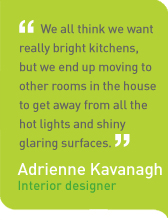In the kitchen: How to create stylish, efficient lighting
In the kitchen: How to create stylish, efficient lighting

It’s not just about food prep: The kitchen’s a place for entertaining, too
Drop by someone’s house, and you’ll be hard-pressed to find anyone lounging in the living room or eating in the dining room.
Where is everyone? Probably in the kitchen.
As the new focal point of our homes and our lives, the kitchen has moved beyond a basic room for food storage and cooking to a centre of dining, relaxing, entertaining and even working.
Because it’s been transformed from scullery to social hub, the kitchen has become a bigger energy hog. That makes it the perfect candidate for energy-efficient lighting, whether it’s a brand new kitchen, a down-to-the-studs remodel, or a low-budget facelift.
So, how do you create a lighting plan for your kitchen that’s energy efficient, but also stylish and inviting? Here are a few tips from Adrienne Kavanagh, principal of Vancouver-based AK Interiors.
Reduce and relocate
According to designer Kavanagh, you should start by reducing the number of lights in the room and relocating light to the right areas.
“We all think we want really bright kitchens,” says Kavanagh, “but we end up moving to other rooms in the house to get away from all the hot lights and shiny, glaring surfaces. It tires the eyes and reduces the intimacy of the space.”
Instead of flooding a kitchen in light, Kavanagh advises making lighting more subtle and functional.
“Your kitchen will still be bright, but the brightness will be relocated to the right areas.”
Start at the top
Start with your ceiling light. In a new kitchen or major reno, Kavanagh recommends installing ENERGY STAR® recessed potlights for an uncluttered look that doesn’t compete with sparkling cabinetry, countertops and backsplashes. But don’t go overboard.
“Interior design went through a phase of flooding kitchens with dozens of potlights,” she cautions. “You only need a few to get an overall glow in the room. Too many waste energy and give the ceiling a very busy look.”
Some designers add extra potlights to highlight a kitchen’s traffic paths.
Kavanagh’s expert tip to achieve the same result with fewer lights? “Angle the potlights so they shine partly on the edge of countertops and partly on the floor.”
Retrofit to save money and energy
 If you already have old potlights in the ceiling, Kavanagh advocates buying an ENERGY STAR CFL or LED retrofit kit to update your kitchen and lower your energy bills.
If you already have old potlights in the ceiling, Kavanagh advocates buying an ENERGY STAR CFL or LED retrofit kit to update your kitchen and lower your energy bills.
“They’re easy to install and have a smaller trim, which modernizes the look. Choose a reflective trim to distribute more light around the room.”
Kavanagh recommends replacing other types of outdated kitchen lights — such as old fluorescent tube lighting that buzzes and flickers — with flush-mounted fixtures, which cast a more subtle glow, or track lighting, which can be positioned to shine light on different areas.
“Choose a smaller fixture with a slimmer profile. Unlike the dining room, you don’t want your kitchen’s ceiling fixture to be the room’s focal point.”
If you can’t afford to replace the fixture just yet, swap old bulbs with ENERGY STAR CFLs or LEDs. Even old fluorescent fixtures can be made more energy efficient by adding new tubes.
Kavanagh chooses a neutral white bulb colour for her clients. “Not too warm, which can be too yellow, or too cool, which can be too blue. You don’t want to detract from your kitchen’s decorative colours.”
Light the task at hand
Next, think about how to make your kitchen’s light more functional. Kavanagh is a big fan of under-cabinet lighting for illuminating tasks such as food prep.
“When you’re finished cooking, it can be used on its own to set a mood for entertaining, or as a nightlight.”
If you’re installing new cabinetry, recessed lighting can be built into the bottom of cabinets. The upside? No visible wires or plugs.
But even if you’re sticking to your existing cabinets, portable under-cabinet lighting has become easier than ever to install.
“There are so many energy-efficient options available now that have a great look, like new fluorescent strip lighting and LED puck lights, says Kavanagh.
If you have an island, Kavanagh suggests adding one or two pendant lights above it to illuminate your slicing and dicing. But, like potlights, too many can be a bad thing.
“In decorating magazines, you’ll often see five pendant lights hanging over an island. It looks beautiful in a photo, but in reality it’s too busy and bright. Plus, think of all that dusting and cleaning!”
Keep it on the bright side: colours matter
If you want to save even more energy, consider that the colour of your kitchen’s walls, cabinets, countertops and backsplashes can impact lighting efficiency.
“The lighter your paint and finishes are, the more light is reflected around the room, and the less work your lights have to do,” explains Kavanagh.
Learn more about paint colours and lighting efficiency
Take control: switches & dimmers
Whether you want to add drama with darker shades or decide to keep your decor light and bright, it’s critical to develop a plan for how you’ll control your lights.
“Group lights on separate control switches, so you can turn on a few lights at a time for those small, quick tasks and prevent energy overuse. Add dimmers and you’ll not only save more energy, but set a more restful mood for relaxing and entertaining.”
It makes sense to carefully plan a lighting scheme for your kitchen — one that’s as energy saving as it is stylish and inviting — after all, it’s where we end up spending most of our time.
Source: bchydro






